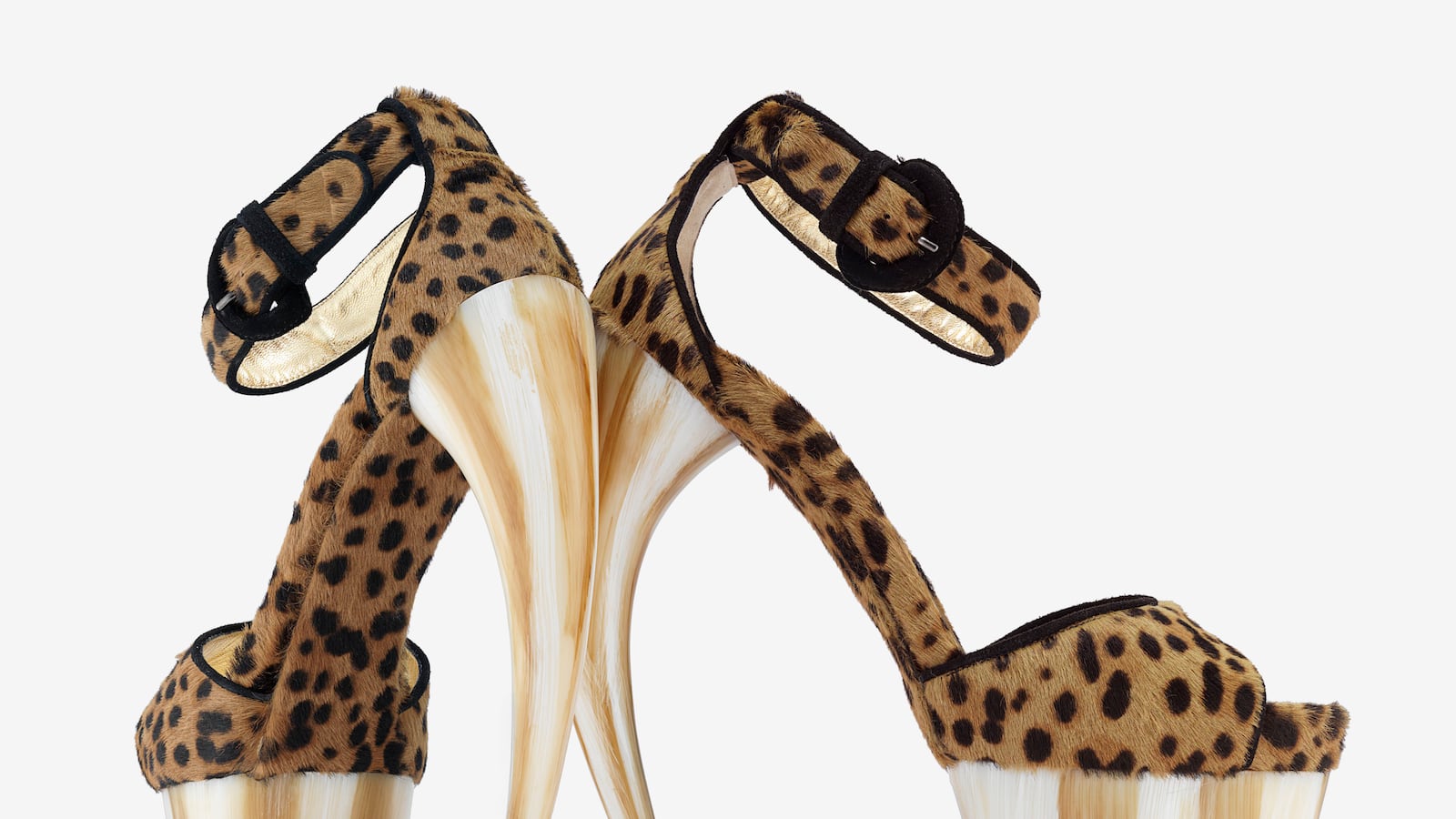If there was one moment that cemented Marilyn Monroe’s femme fatale reputation, it was her 116-foot, hip-swinging strut toward Niagara Falls in the 1953 film Niagara. In the fevered debate over how she perfected her hypnotic wiggle, a theory emerged that she had shaved down one of the heels of her stilettos (she owned 40 pairs by Salvatore Ferragamo). “I don’t know who invented high heels, but all women owe him a lot,” she famously cooed.
It’s a well-worn (and possibly apocryphal quote), but one that rings true when touring the Brooklyn Museum’s new show Killer Heels: The Art of the High Heeled Shoe which showcases the high heel as a symbol of femininity, sex, power, and submission. And, naturally, a pair of sleek black Ferragamo stilettos worn by Monroe are among more than 160 shoes on display.
The exhibit explores the historical and social significance of elevated shoes, from the flamboyant mid-17th century Italian chopines and 19th century embroidered silk Chinese Manchu shoes, to the towering, eight-inch-heel platform booties designed by United Nude for Lady Gaga.
Indeed, Killer Heels sees the elevated women’s shoe through every flight of fancy—practical and wildly impractical—including the surrealist Shoe Hat by Elsa Schiaparelli and Salvador Dali, Jean Paul Gaultier’s inverted Eiffel Tower stiletto, Iris van Herpen’s 3-D wedge, and the Rainbow platform sandal Ferragamo made for Judy Garland. (Ferragamo’s 1937 sandal marked a reemergence for platforms, so much that the New York Times reported in 1940 that men were nostalgic for the erotic allure of “those delicate high insteps pattering along on spindle heels.”)
PHOTOS: Up, Up, Up: The Hottest Heels in History

The exhibit highlights striking visual references: a gilded Rococo table is echoed in a foliated Miu Miu platform wedge, while early sex-kitten heels are situated near their contemporary counterparts from Christian Louboutin and Manolo Blahnik. “I wanted to have a range of designers, but I couldn’t do a show about shoes and exclude Christian Louboutin and Manolo Blahnik,” says Lisa Small, the museum’s curator of exhibitions.
The exhibit also features non-traditional shoe design from those native to other industries, including the artist Damien Hirst’s polka-dot bootie and a futuristic leather and fiberglass heel by architect Zaha Hadid.
“One of the show’s main themes is the idea of shoes as objects of transformation,” says Small. We see this metamorphosis not only in Cinderella’s glass slipper and the Chinese bound foot shoe (“perhaps the most literal example”), but in the subtle way high heels change a woman’s posture, highlighting the curve of her spine, making her breasts and bum protrude, her femininity more pronounced.
Less subtle--and more sexually charged--was the emergence of the stiletto, which became ubiquitous in the 1950s after manufacturers inserted steel spigots into the heel of a shoe, making it possible for women to stand safely on thinner, higher heels. And stilettos evoked the danger of a woman’s sexual power--its name derives from the word “dagger”—making it the original “killer heel” and a symbol of fetish.
That dangerous association has become increasingly literal in recent years as heels reach new gravity-defying heights, prompting a spate of criticism of fashion designers for forcing their models to walk the catwalk in precariously tall shoes.
In 1993, diva supermodel Naomi Campbell got her comeuppance from Vivienne Westwood’s Super Elevated Gillie heels when she famously toppled over on the runway. The shoes that almost killed Campbell have also received the museum treatment, recently having been displayed at a British gallery.
Models are always a few faltering footsteps away from breaking an ankle (or worse). But to ask why women subject themselves to the pain of pinched toes and wobbly ankles misses the point of haute couture fashion, which has always been more provocative than practical. Indeed, many of the shoes on view in Killer Heels aren’t even wearable.
When they are wearable, high heels are often viewed as a symbol of male desire—women teetering in uncomfortable shoes to please the opposite sex—and the destroyer of female freedom. (A recent headline on the website Feminist Times nicely sums up the objection: “A feminist in high heels is like [atheist Richard] Dawkins in a rosary.”)
“You could just as easily ask men why they wear neckties, which aren’t particularly comfortable,” says Small. Like heels, the necktie is also a symbol of power, she says, but it’s important to consider what kind of power it is meant to convey. “The necktie has a universal currency of power whereas the high heel doesn’t. It’s too bound up in sexualization and objectification. Yet many women enjoy wearing them because they want to look conventionally sexy or because they like the confidence that comes with extra height.”
The exhibit also features films riffing on high heels, six of which were commissioned by the museum from directors including Steven Klein, Marilyn Minter, Nick Knight. A short clip from the 1959 movie Some Like it Hot pays homage to Monroe as an icon of femininity and references gender-bending tropes in contemporary culture.
“That clip speaks to so many things,” says Small. “First, men in drag discussing the notion of how women should dress, and then Marilyn walks by wearing black stilettos that look almost identical to the ones we have in the show.”
The show provides an engrossing portrait of those designers and visionaries that made the high heel a symbol of status and sex. And to spend an afternoon wandering the Brooklyn Museum is to agree with Monroe’s judgment: we owe them a lot.






